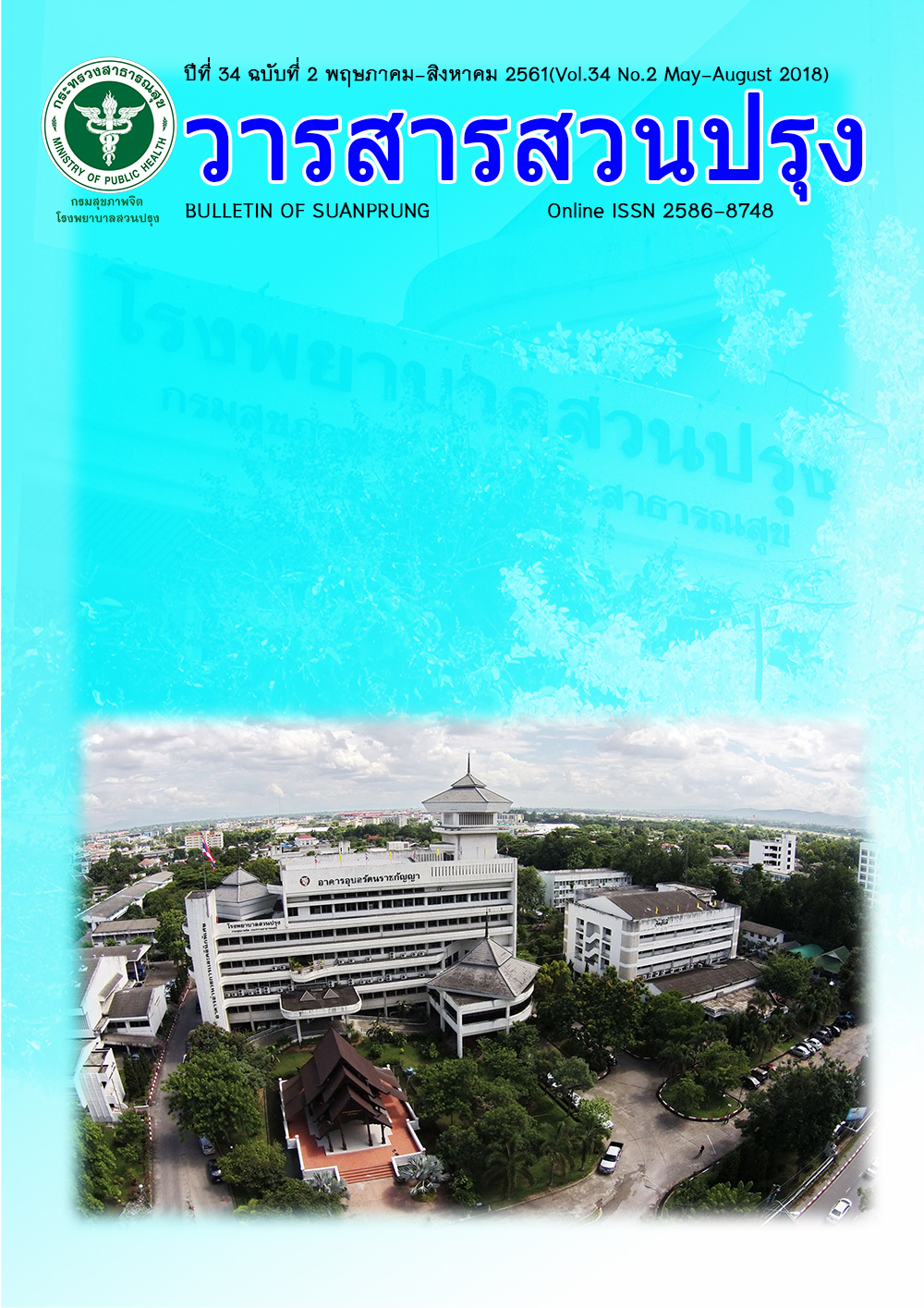Effects of Child-Centered Group Play Therapy on Disruptive Behavior of Elementary Students
Main Article Content
Abstract
Effects of Child-Centered Group Play Therapy on Disruptive Behavior of Elementary Students
Abstract
Objectives: To examine the effects of Child-centered group play therapy on disruptive behavior of elementary students.
Method: The sample group comprised 16 students in grades 4-6, ages 9-11. They were assigned into an experimental group and control group with 8 participants each. The subjects in the experimental group attended a child-centered group play therapy, whereas those in the control group engaged in their normal classroom activities, joining the program after the research procedure was complete. Prior to and after the therapy, as well as in follow-up (after 2 weeks), they responded to a demographic questionnaire. The instrument used was the Thai Youth Checklist base on CBCL (TYC). Data were then analyzed using descriptive statistics and Mixed-design ANOVA.
Results: The results of this study revealed that the posttest and follow-up score of the experimental group was statistically and significantly lower than pretest (p < .001). In addition, the posttest and follow-up score of the experimental group was also significantly lower than control group (p < .05).
Conclusion: Child-centered group play therapy can effectively decrease disruptive behavior of elementary students.
Keywords: Child-centered group play therapy, Disruptive behavior, Elementary Students
ผลของกลุ่มการเล่นบำบัดแบบเด็กเป็นศูนย์กลางต่อพฤติกรรมก่อกวนในเด็ก ระดับชั้นประถมศึกษาตอนปลาย
วรกัญ รัตนพันธ์ * ณัฐสุดา เต้พันธ์ **
บทคัดย่อ
วัตถุประสงค์: เพื่อศึกษาผลของกลุ่มการเล่นบำบัดแบบเด็กเป็นศูนย์กลาง ต่อพฤติกรรมก่อกวนในเด็กระดับชั้นประถมศึกษาตอนปลาย
วัสดุและวิธีการ: กลุ่มตัวอย่างในศึกษาครั้งนี้เป็นเด็กระดับชั้นประถมศึกษาตอนปลายอายุระหว่าง 9-11 ปี จำนวน 16 คน แบ่งเป็นกลุ่มทดลองและกลุ่มควบคุม กลุ่มละ 8 คน กลุ่มทดลองเข้าร่วมโปรแกรม กลุ่มการเล่นบำบัดแบบเด็กเป็นศูนย์กลาง ในขณะที่กลุ่มควบคุมเรียนตามปกติและเข้าร่วมโปรแกรม กลุ่มฯ หลังเสร็จสิ้นกระบวนการวิจัย เก็บข้อมูลโดยใช้แบบสำรวจพฤติกรรม The Thai Youth Checklist base on CBCL (TYC) วิเคราะห์ข้อมูลโดยใช้สถิติเชิงพรรณนาและสถิติทดสอบความแปรปรวน (Mixed-design ANOVA)
ผล: กลุ่มทดลองมีคะแนนพฤติกรรมก่อกวนในช่วงก่อน-หลังการทดลองและ ช่วงติดตามผลแตกต่างกันอย่างมีนัยสำคัญทางสถิติ (p < .001) เมื่อเปรียบเทียบกลุ่มทดลองและกลุ่มควบคุม พบว่าทั้งสองกลุ่มมีคะแนนพฤติกรรมก่อกวนในช่วงหลังการทดลองและช่วงติดตามผลแตกต่างกันอย่างมีนัยสำคัญทางสถิติ (p < .05)
สรุป: โปรแกรมกลุ่มการเล่นบำบัดแบบเด็กเป็นศูนย์กลางสามารถลดพฤติกรรมก่อกวนในเด็กระดับชั้นประถมศึกษาตอนปลายได้อย่างมีประสิทธิภาพ
คำสำคัญ: การเล่นบำบัดแบบเด็กเป็นศูนย์กลาง, พฤติกรรมก่อกวน, เด็กระดับชั้นประถมศึกษา ตอนปลาย
Article Details
บทความหลังผ่านการปรับแก้จากกองบรรณาธิการแล้ว เป็นลิขสิทธ์ของวารสารจิตเวชวิทยาสาร โรงพยาบาลสวนปรุง กรมสุขภาพจิต กระทรวงสาธารณสุข ห้ามเผยแพร่เพื่อประโยชน์ทางการค้าโดยไม่ได้รับอนุญาต แต่อนุญาตให้เผยแพร่บทความดังกล่าวเพื่อประโยชน์ทางการศึกษาแก่ประชาชนทั่วไป ทั้งนี้กองบรรณาธิการไม่จำเป็นต้องเห็นด้วยกับบทความหรือข้อคิดเห็นใดๆ ที่ปรากฏในวารสารสวนปรุง
References
Abidin, R. R., & Robinson, L. L. Stress, biasere, or professionalism: What
drives teacher' referral judment of student with challenging behaviors?. Journal of Emotional and Behavioral Disoders2002;10:204-12.
Achenbach, T. M., & Rescorla, L. A. Manual for the ASEBA School-Age Forms & Profiles. Burlington, VT: University of Vermont, Research Center for Children, Youth, & Families 2001. [online]. Available from:www.aseba.org/schoolage.html [2016 Feb 20]
American Psychological Association, Task Force on Resilience and Strength in Black Children and Adolescents. Resilience in African American children and adolescents: A vision for optimal development. Washington, DC; 2008 [online]. Available from: www.apa.org/pi/cyf/resilience.html [2016 Feb 15]
Blanco, P. J., & Ray, D. C. Play therapy in elementary schools: A best practice for improving academic achievement. Journal of Counseling and Development2001;89(2):235-43.
Fitzpatrick, M., & Knowlton, E. Bringing evidence-based self-direction intervention practices to the trenches for students with emotional and behavioral disorders. Preventing School Failure: Alternative Education for Children and Youth2009;53(4):253-66
Kaplan, A., Gheen, M., & Midgley, C. Classroom goal structure and student disruptive behaviour. The British Journal of Educational2002;72:191-212.
Landreth, G. L. Play therapy: The art of the relationship. 3thed. New York: Routledge; 2012.
Landreth, G. L., Ray, D. C., & Bratton, S. C. Play therapy in elementary schools. Psychology in the Schools2009;46(3):281-89.
Ray, D. C., & A. A. Practical person-centered theory application in the schools. In A. Vemon,& T.Kottman(Eds.), Counseling theories: Practiceal applications with children and adolecents in school setting. Denver,CO: 2009. P.1-45
Yalom, I. D., & Leszcz, Molyn. The theory and practice of group therapy, 4th ed. New York: Basic Books, 1995.
